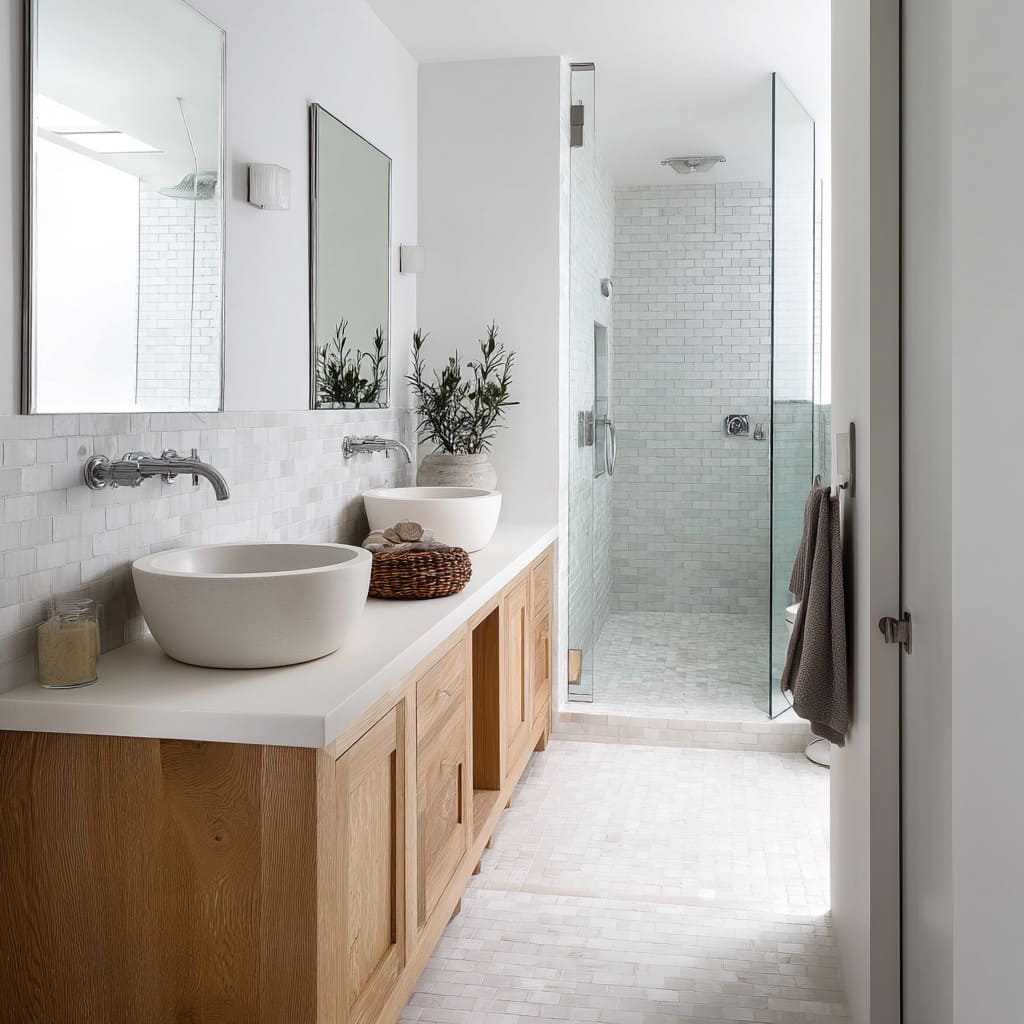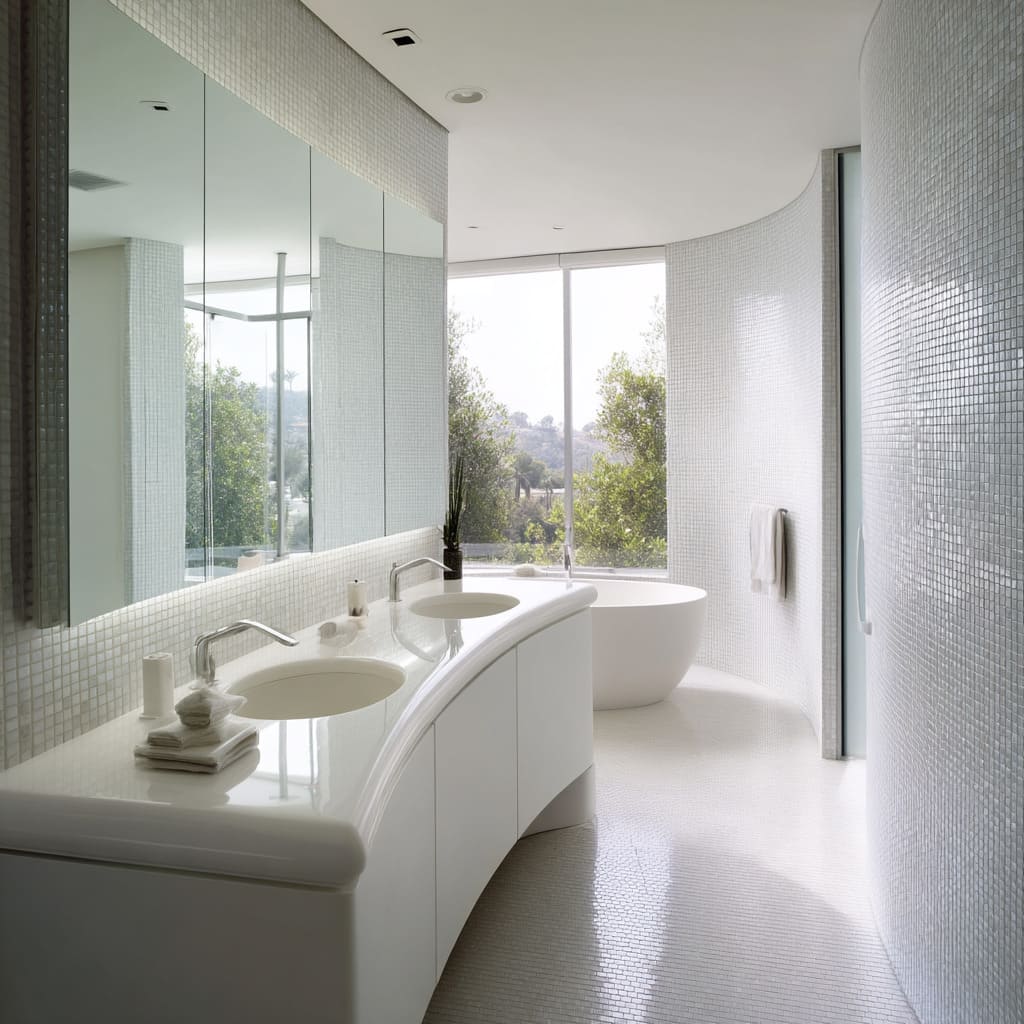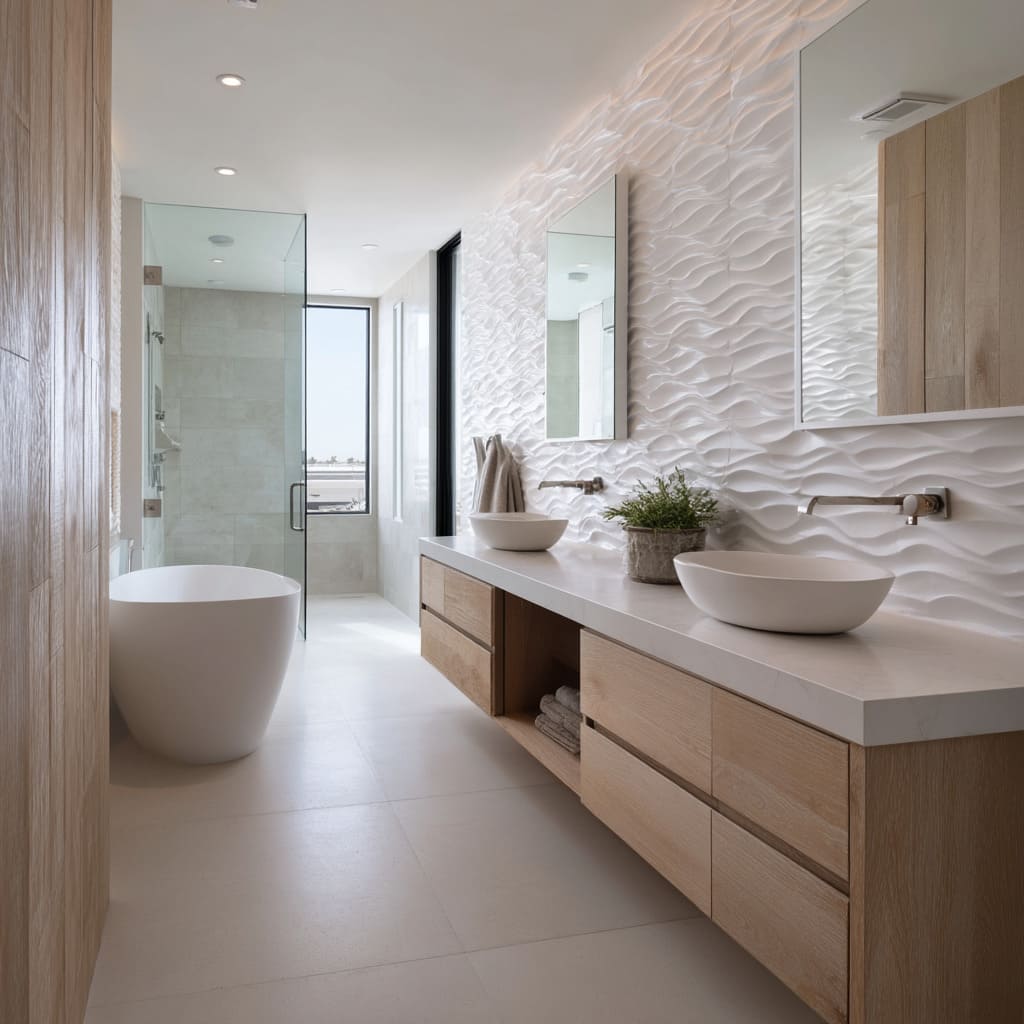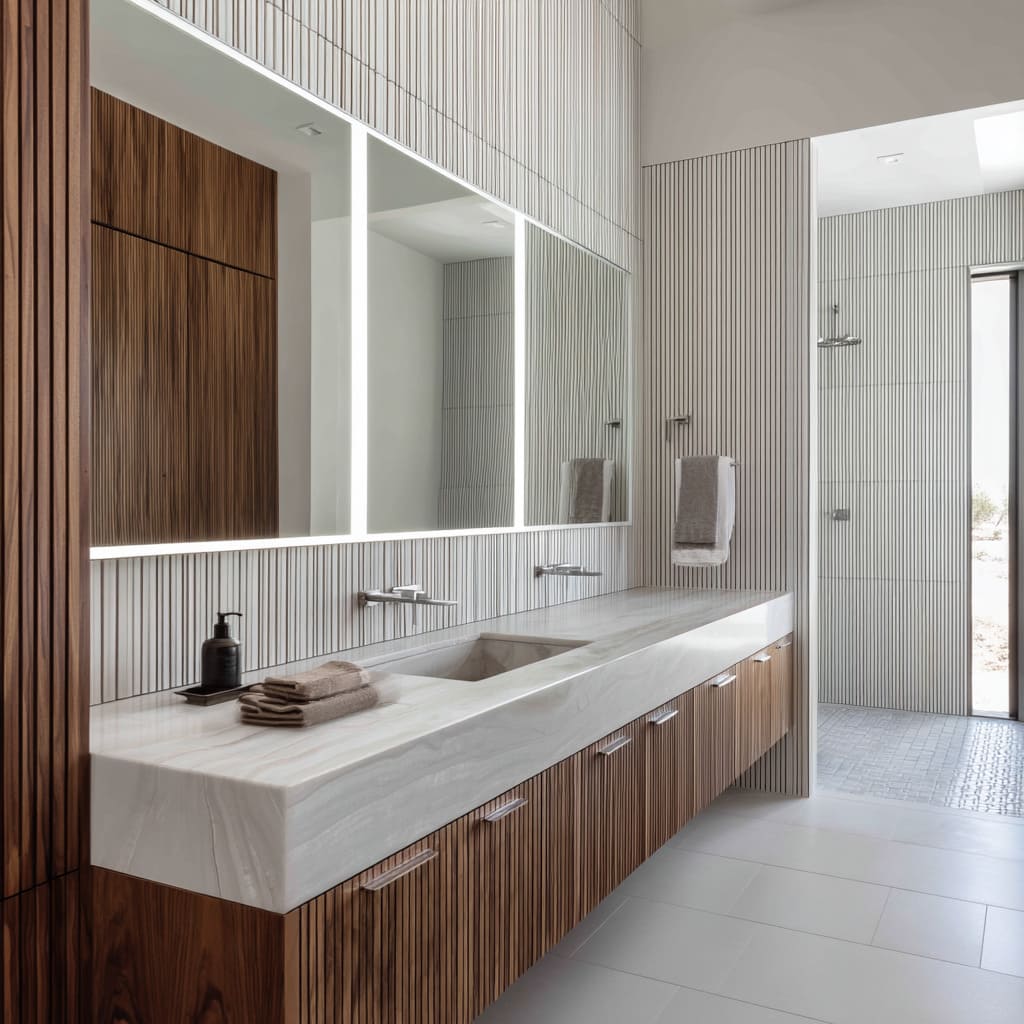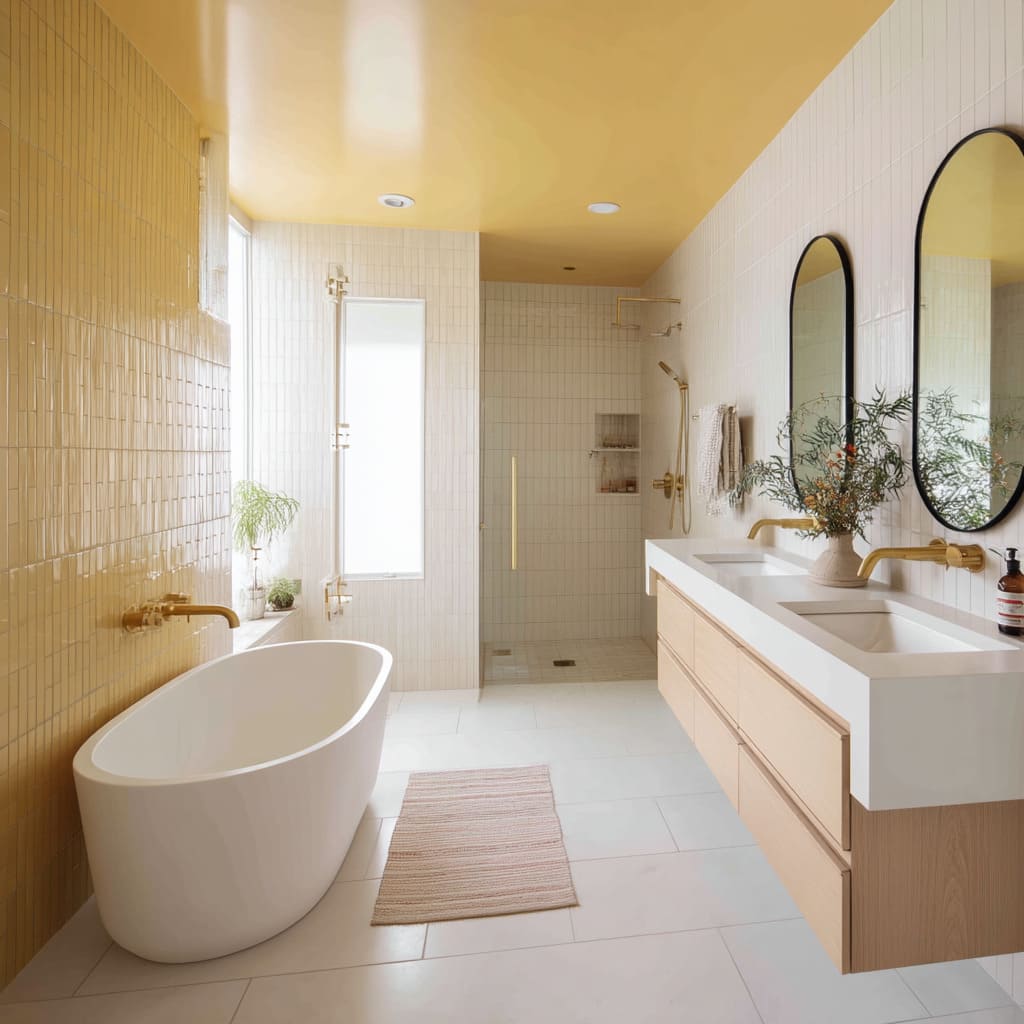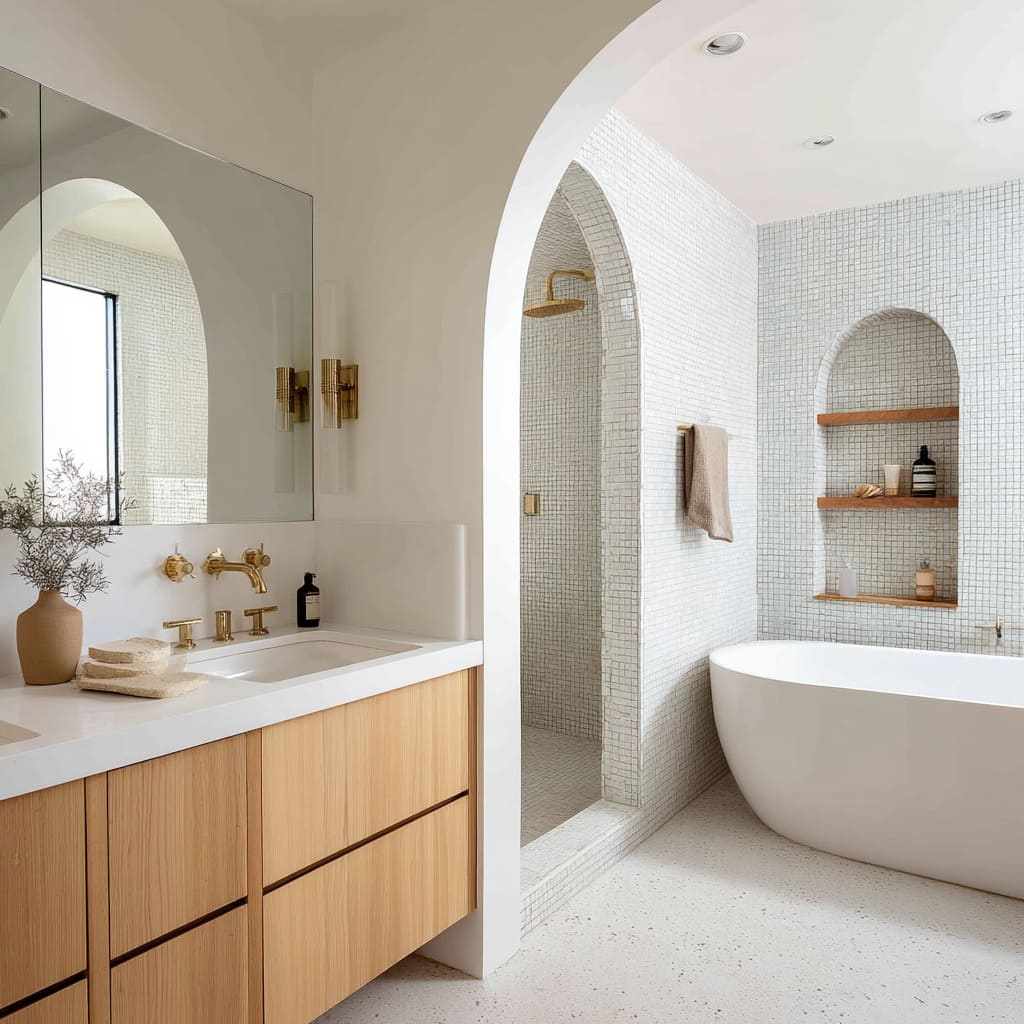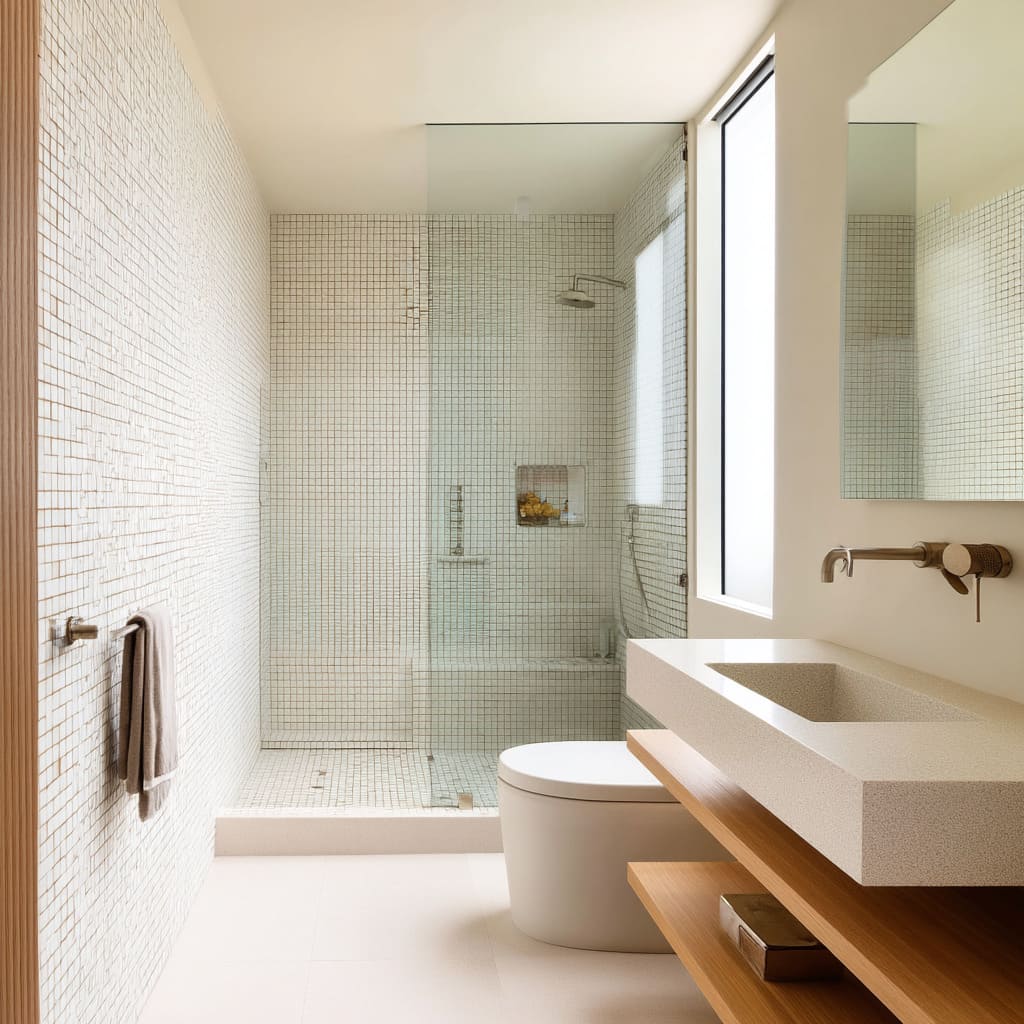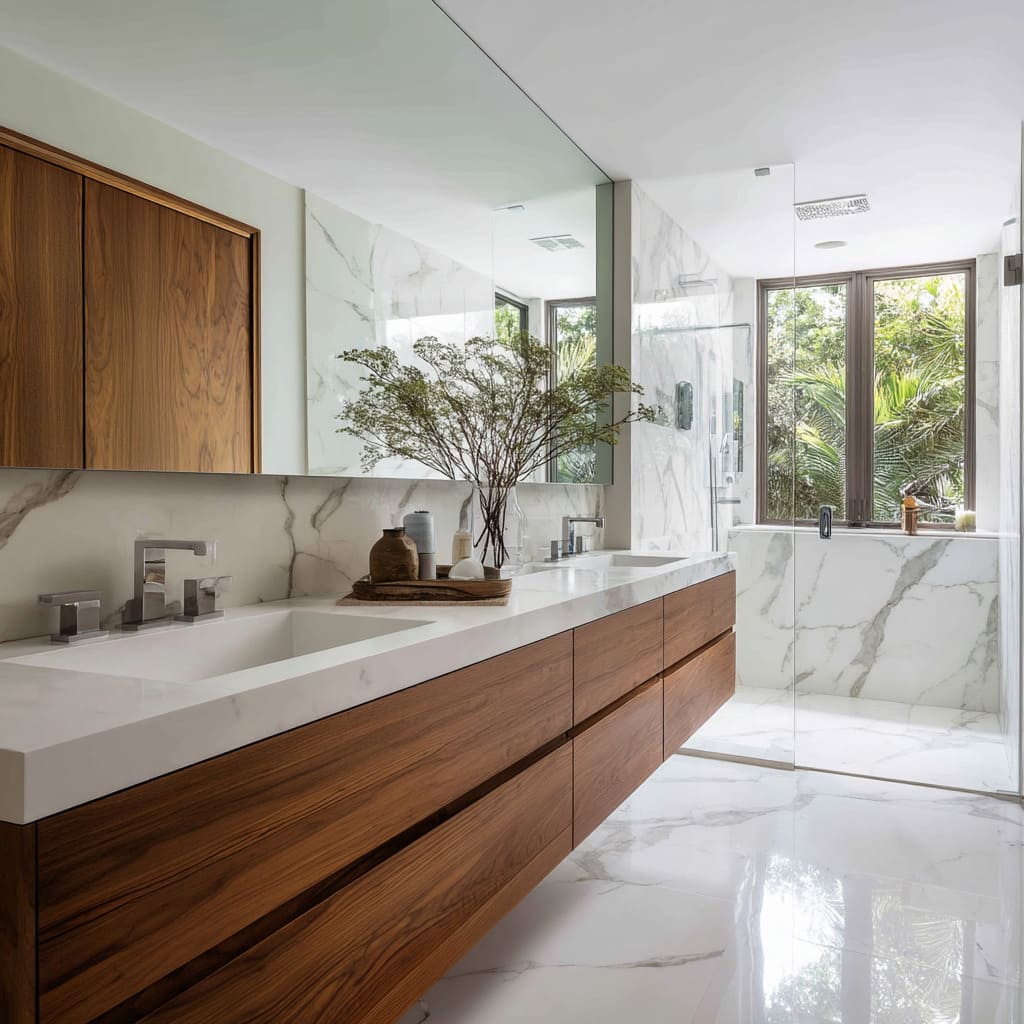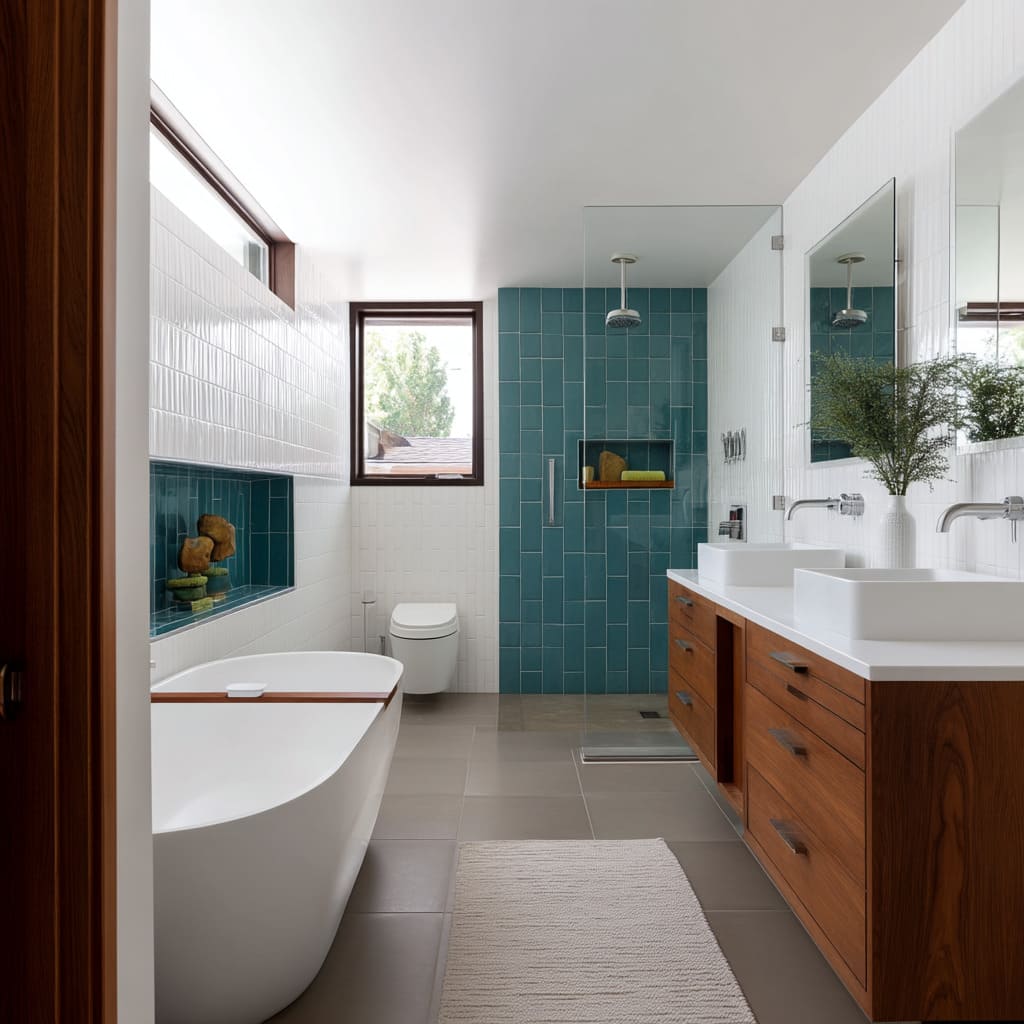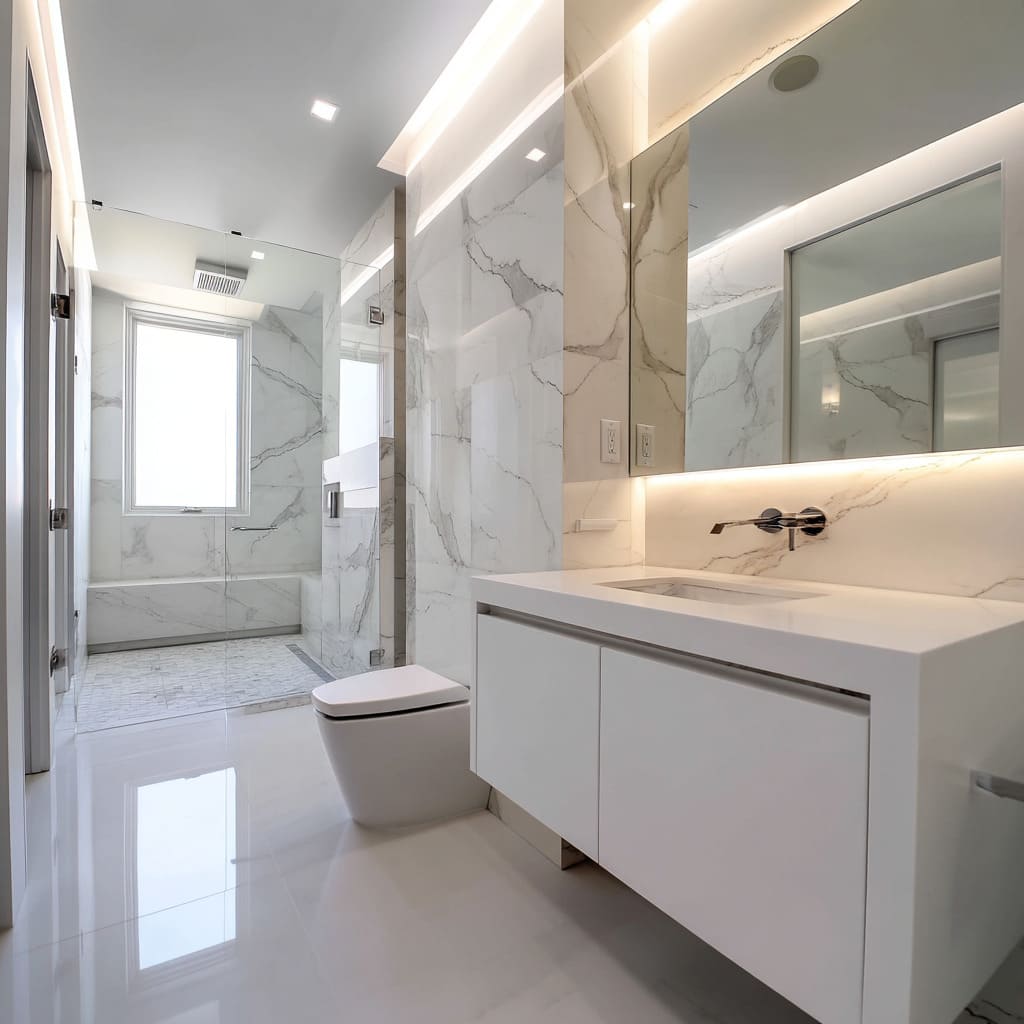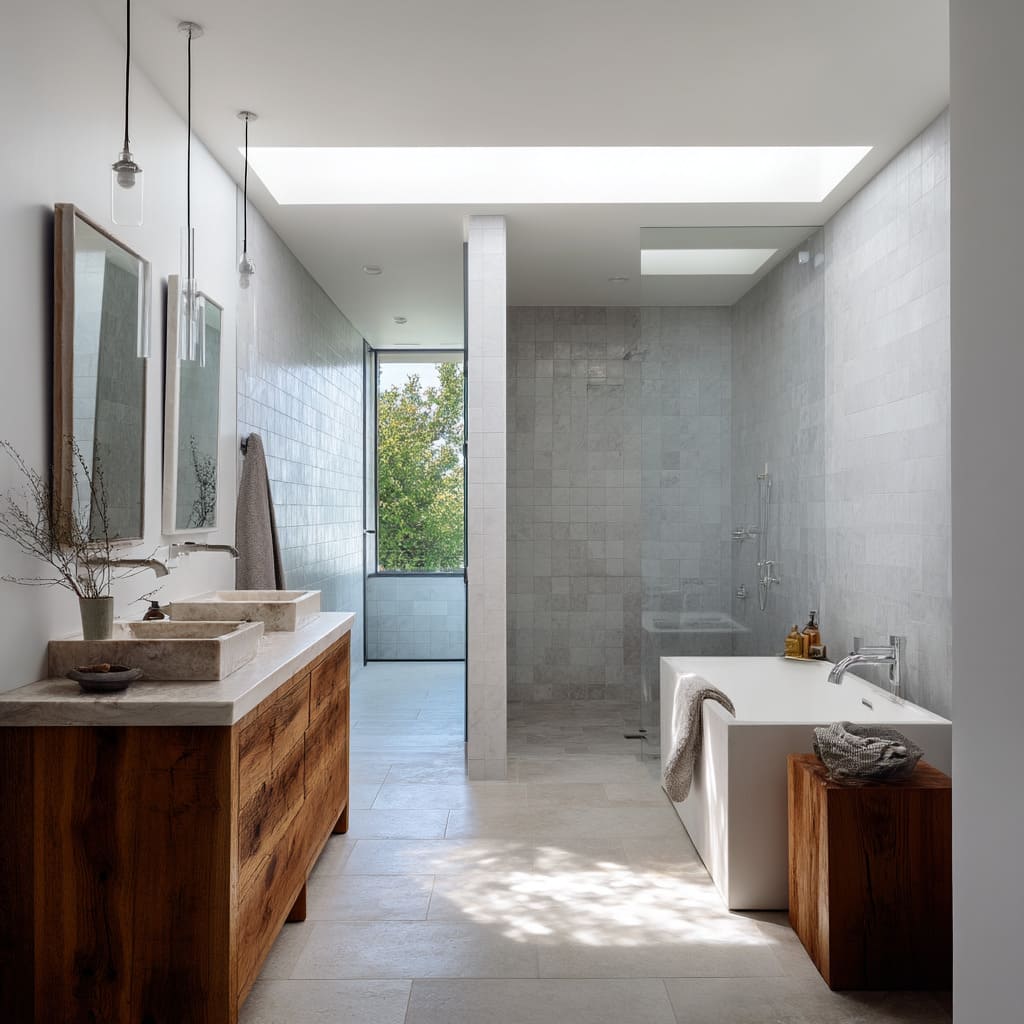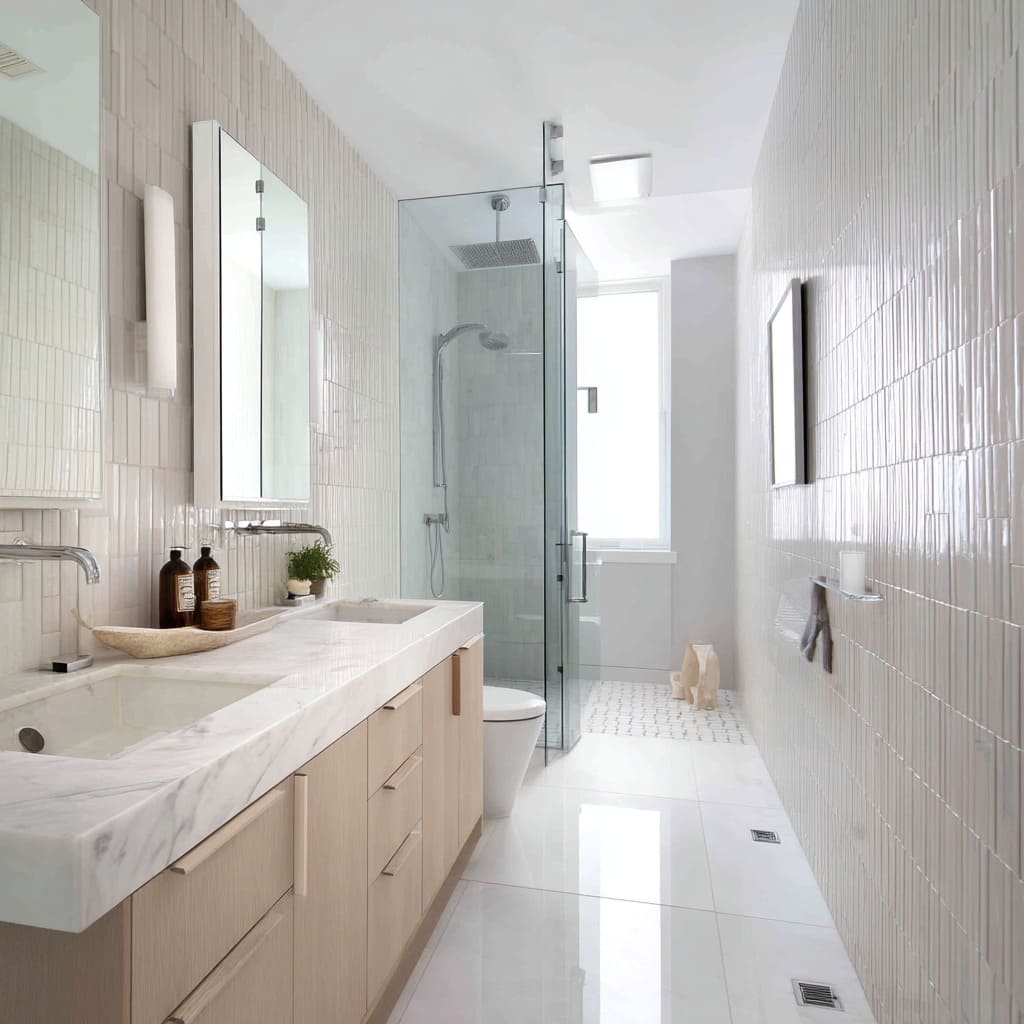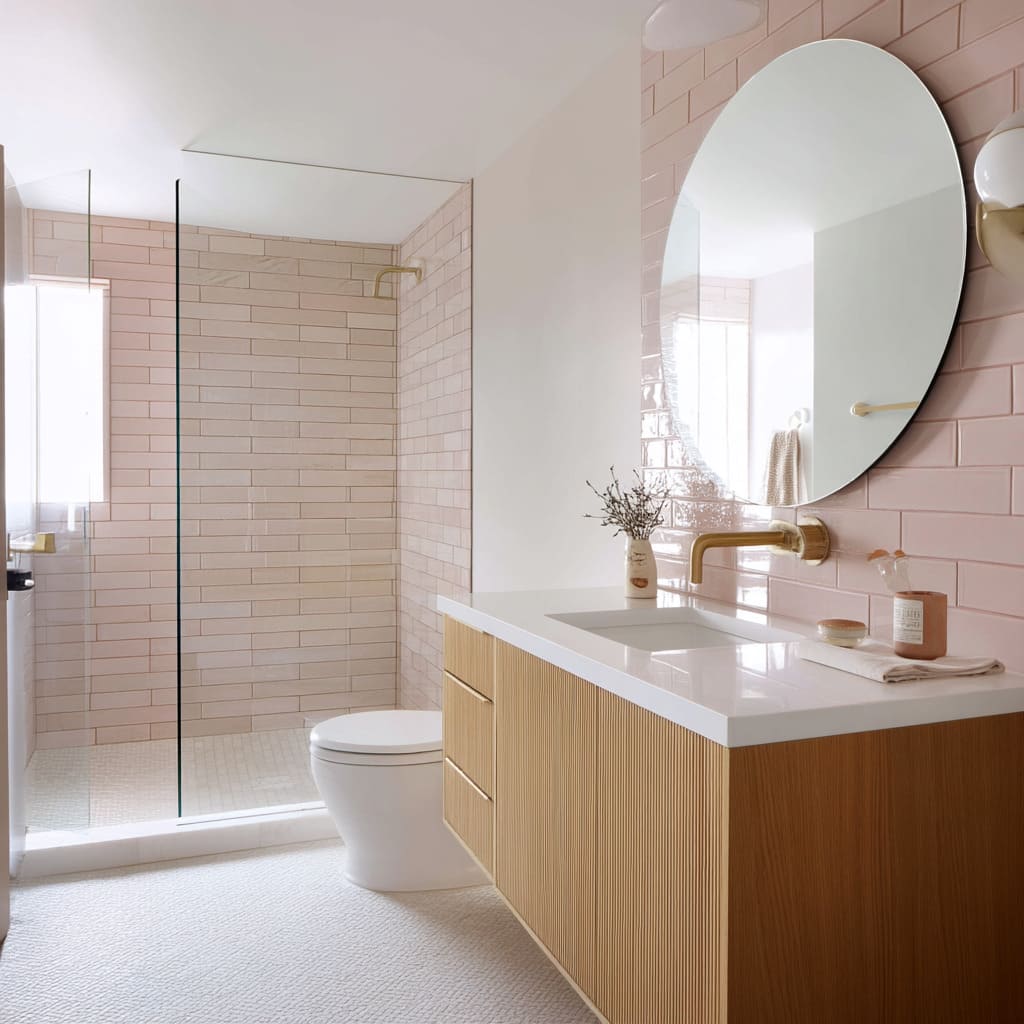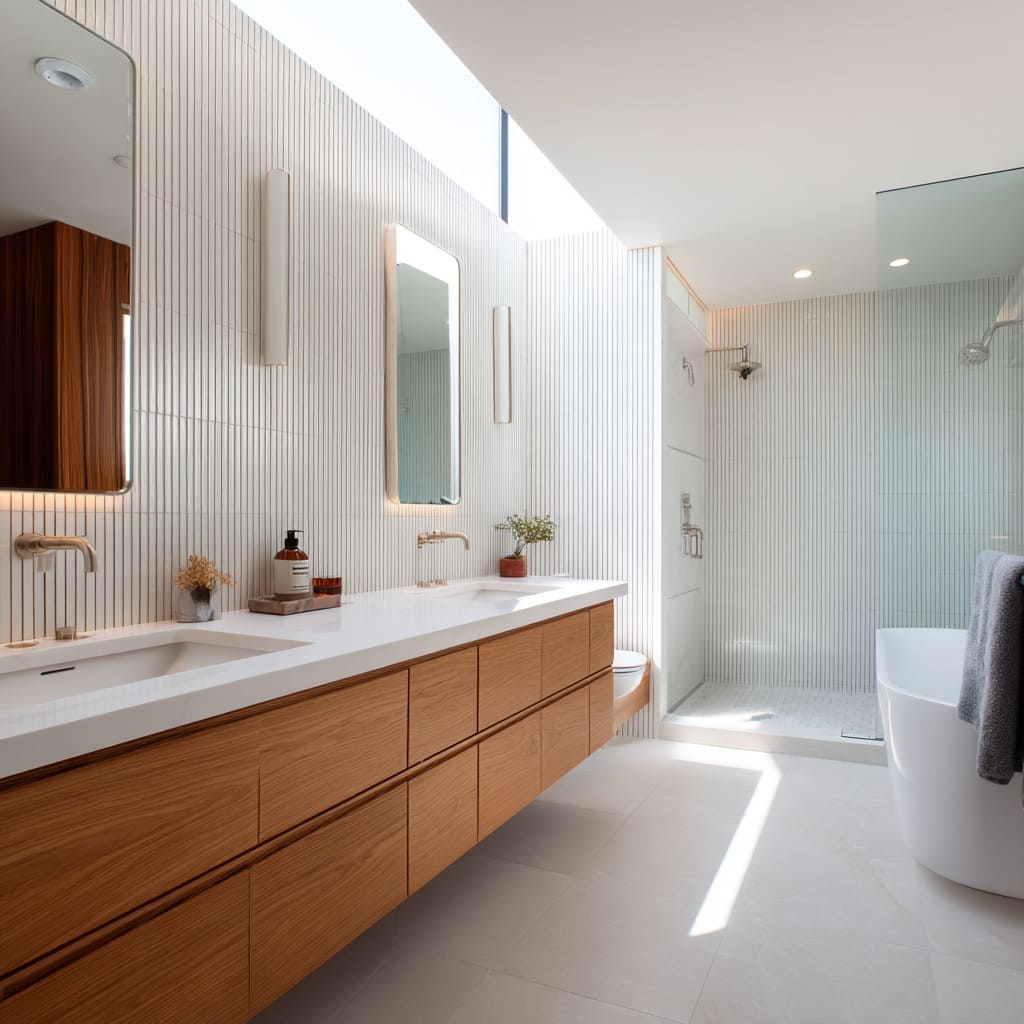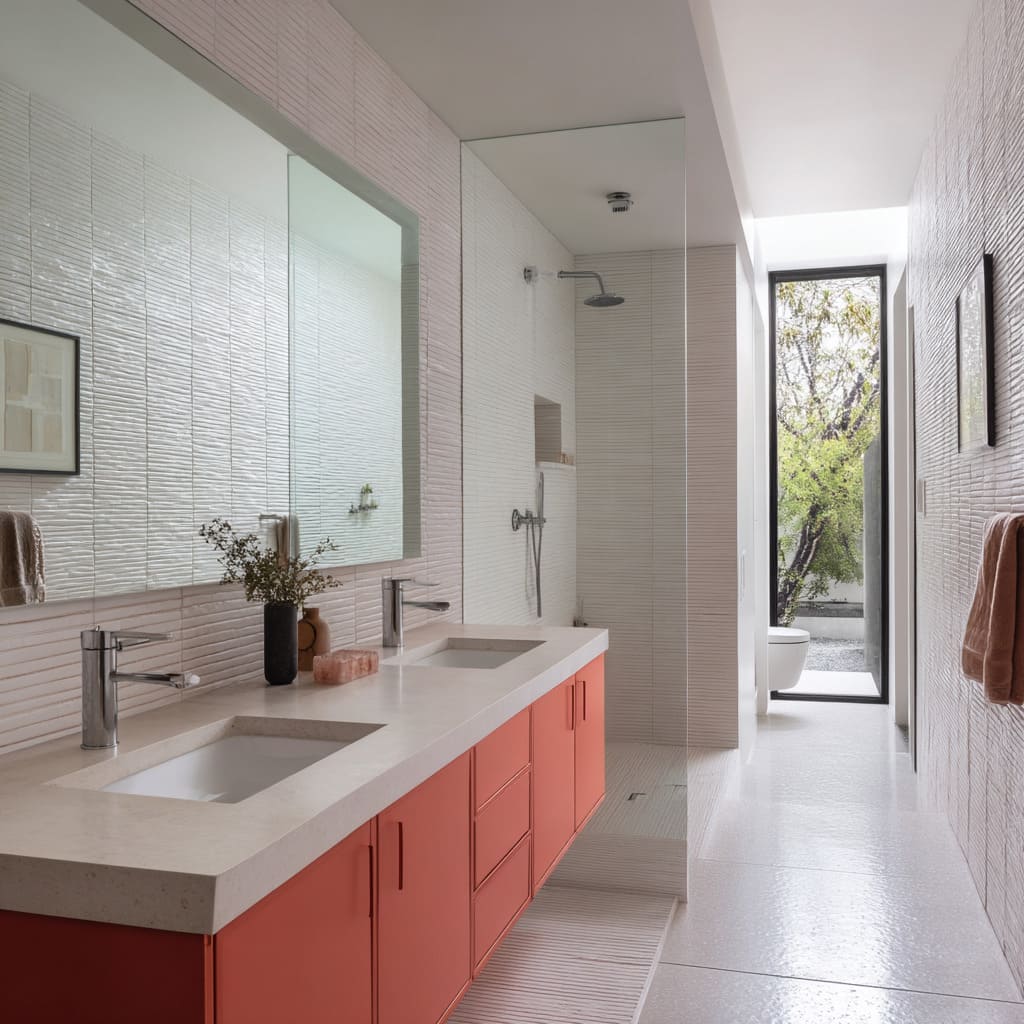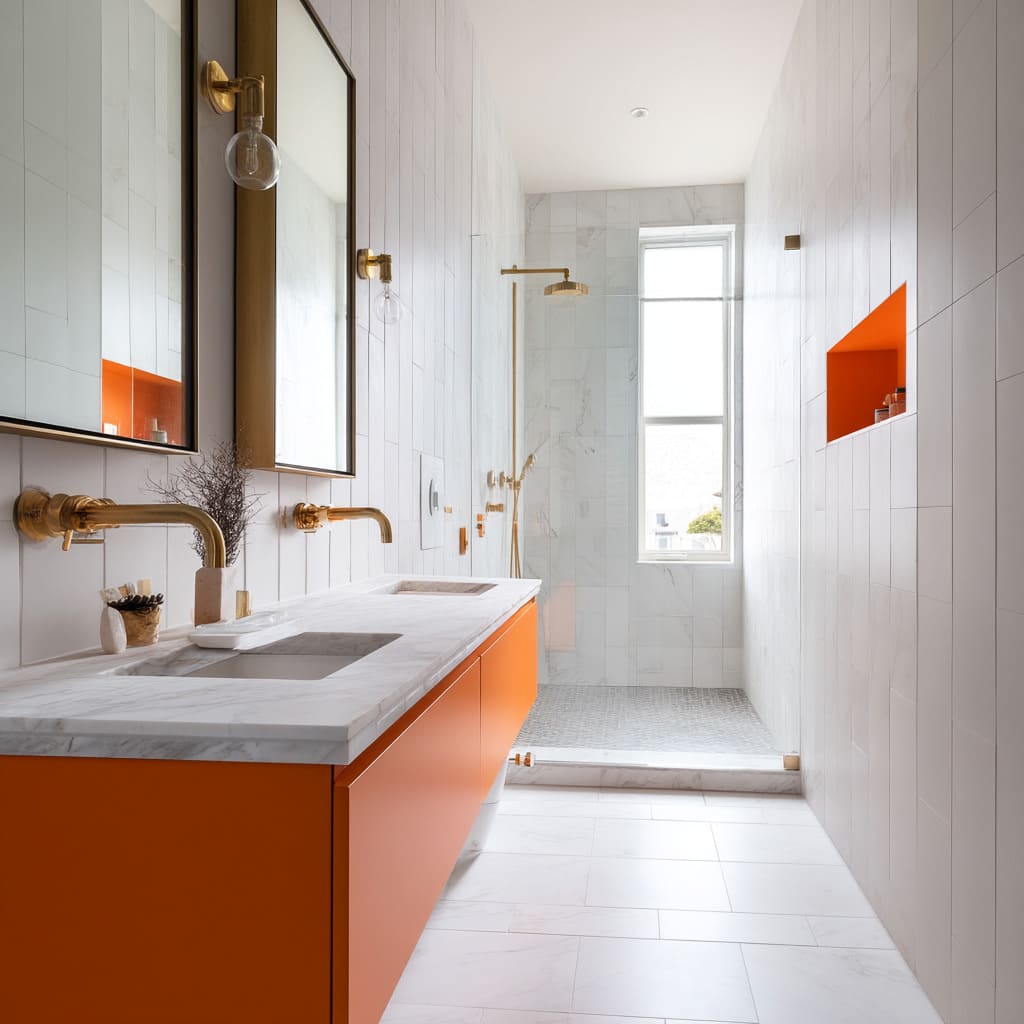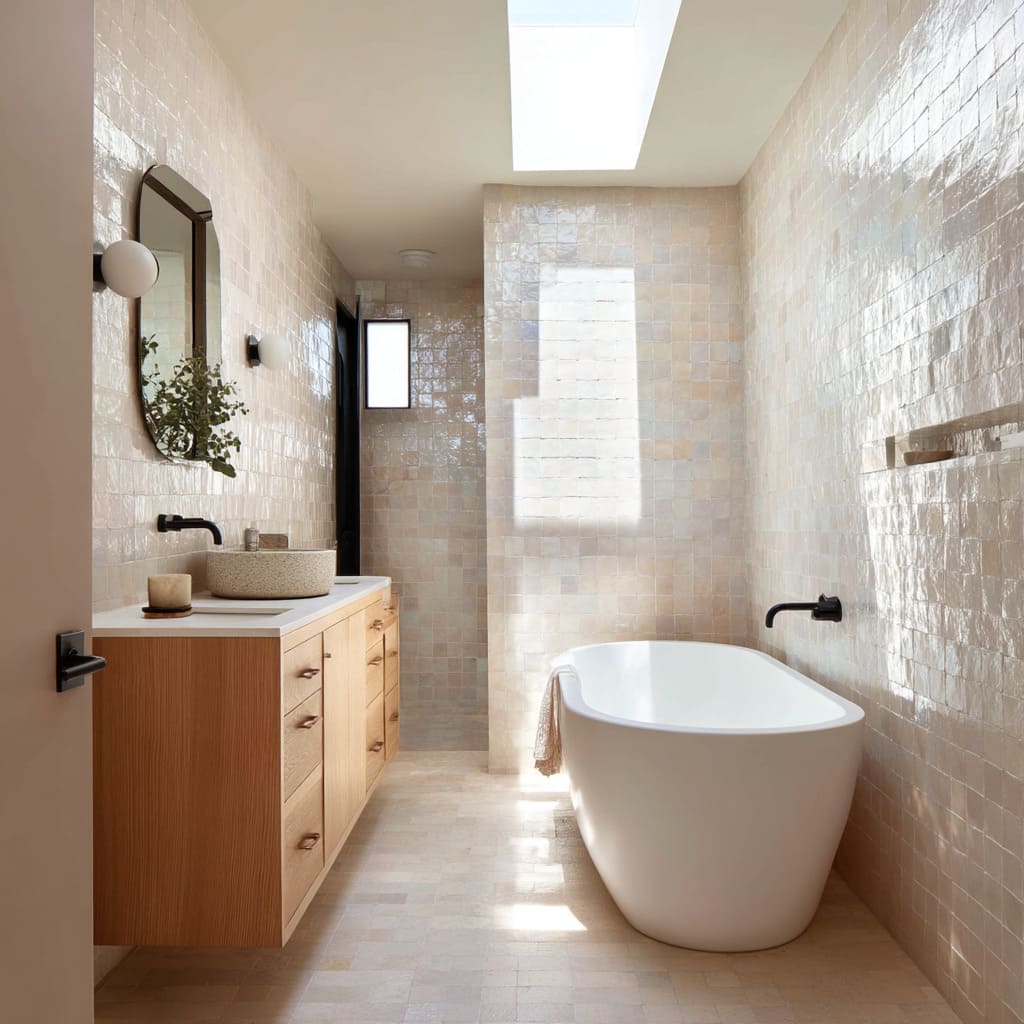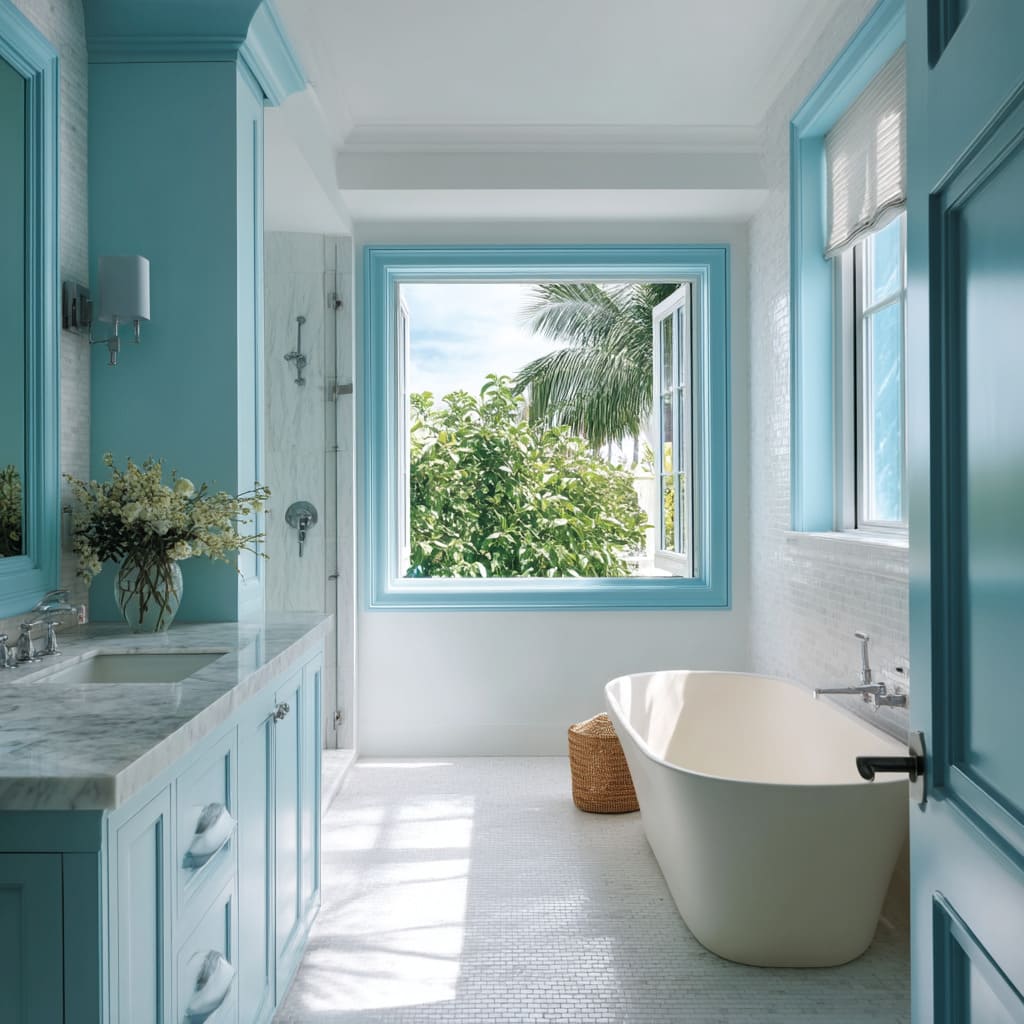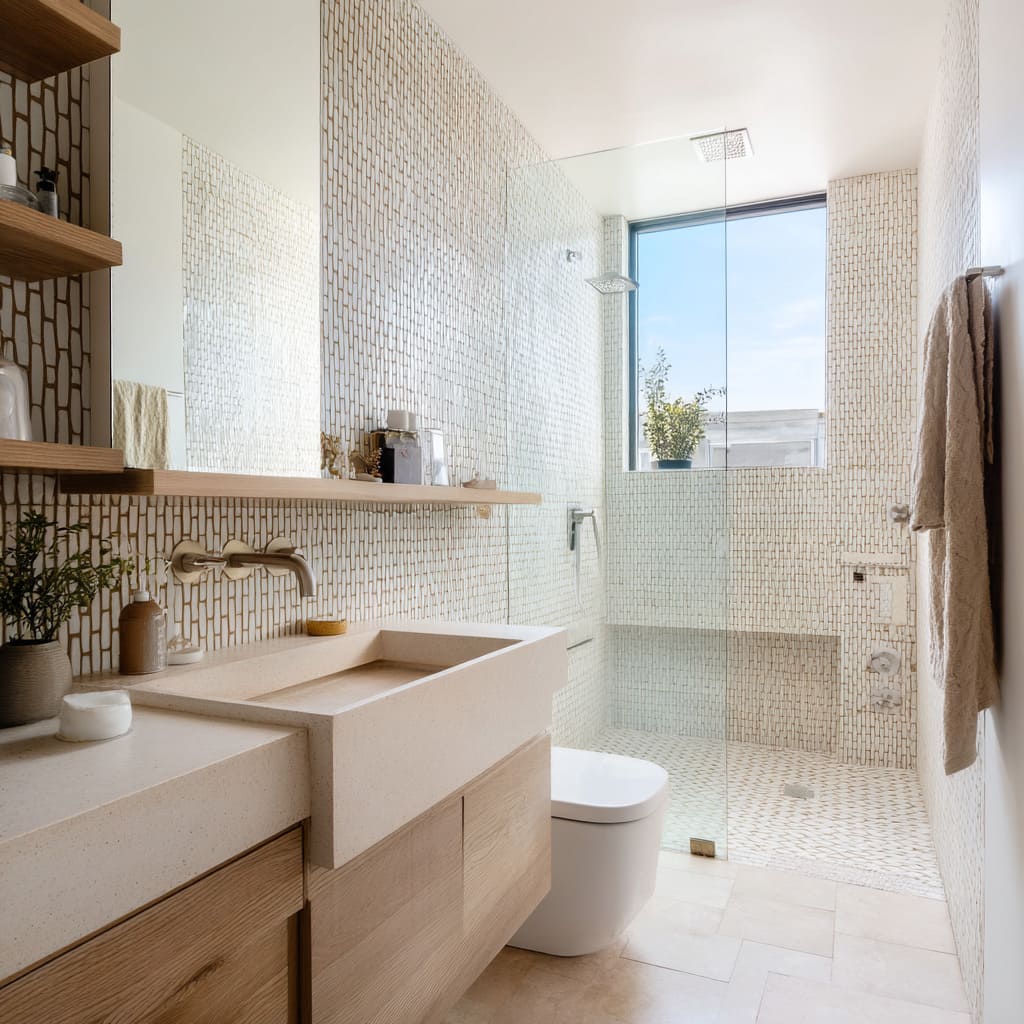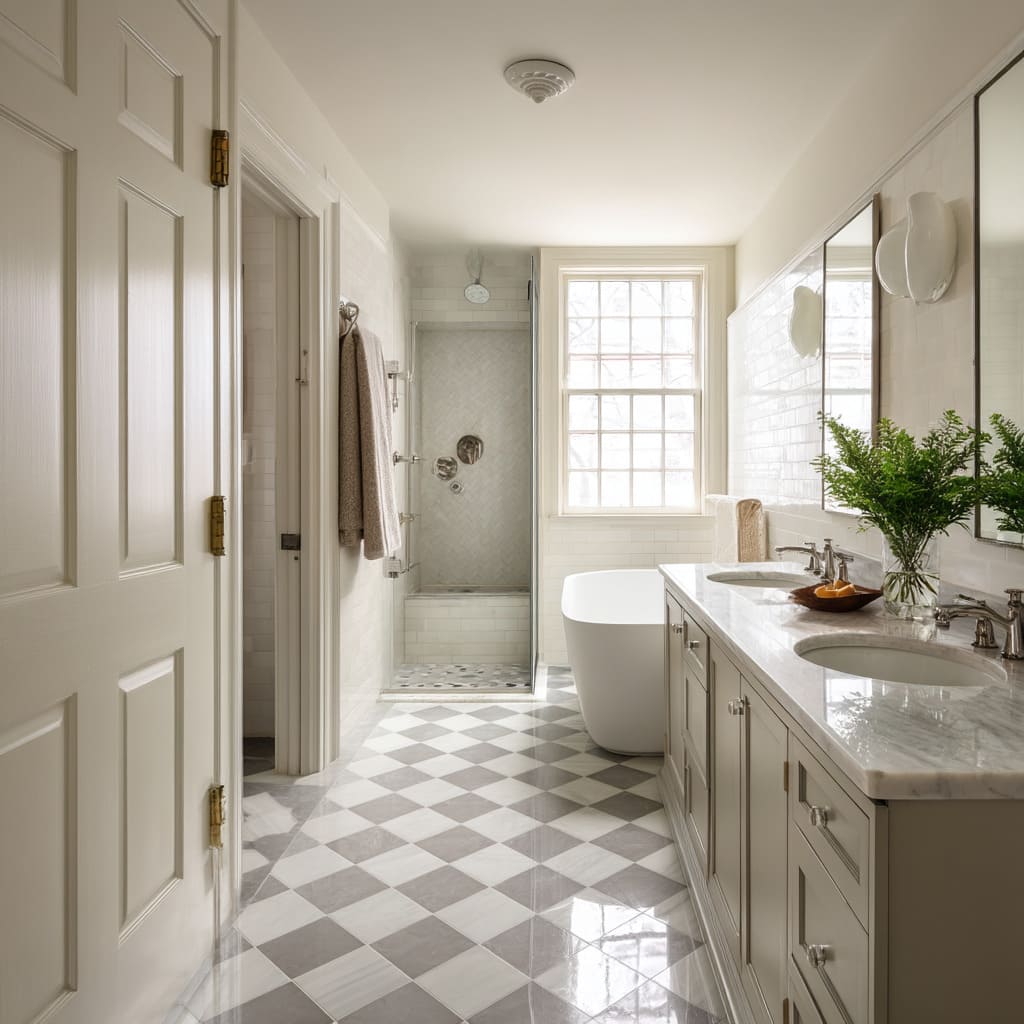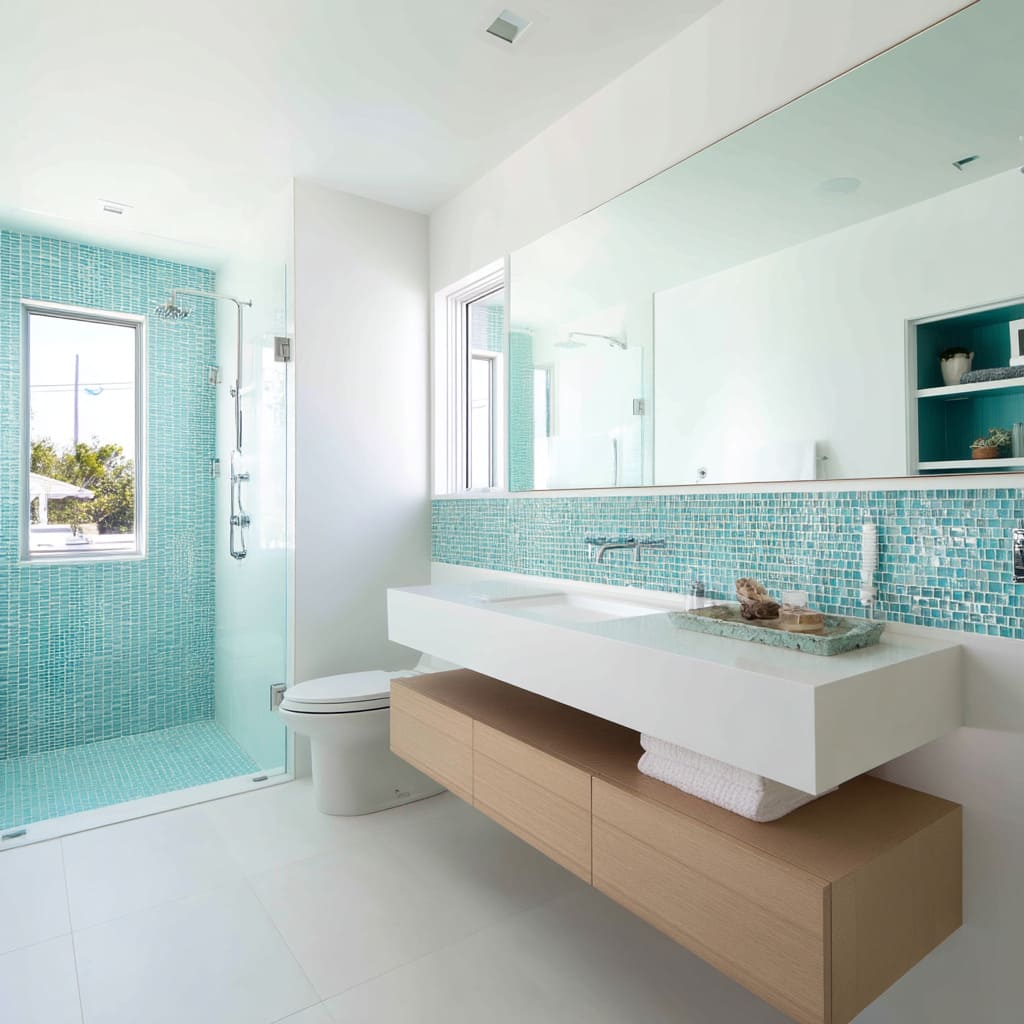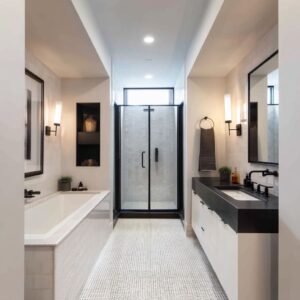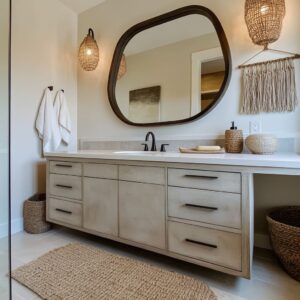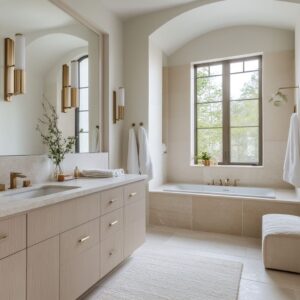White tiles have long been a familiar sight in bathrooms, but today they are used with far greater creativity and precision. Across high-end American homes, the approach to bathroom design has shifted.
White surfaces are no longer seen as passive or empty; instead, they shape light, movement, and texture throughout the day. Designers are choosing finishes not only for color but for the way they react with natural daylight, using every surface to build a sense of rhythm and quiet richness.
This new language of white tiles embraces fine details—fluted profiles, handmade textures, sculptural waves—all carefully arranged to create layered, tactile spaces. Vanities float above the ground, opening up sightlines and allowing walls and floors to breathe without interruption.
Small accents of wood or confident bursts of color add character without breaking the calm, while subtle touches like perfectly aligned grout lines, frameless glass, and hidden lighting reveal the craftsmanship behind what first appears to be simple.
In this article, a closer look at modern bathroom spaces shows how thoughtful choices in texture, material, orientation, and subtle color placement turn white tile bathrooms into living, responsive environments rather than static, blank rooms. Whether inspired by city lofts, coastal homes, or nature-connected retreats, today’s white-tiled bathrooms offer an extraordinary balance of calmness, movement, and quiet depth.
Macro Shift: White Tiles as Light-Modulators, not Blank Canvases
A fresh understanding of bathroom white tiles design has quietly reshaped how spaces come alive throughout the day. Instead of serving as a plain surface, white tiles are now treated as active players in how light moves across the room.
Choices of texture — from fine ribbing and micro-mosaic weaves to handmade irregular glazes and flowing 3-D surfaces — turn every wall into a subtle stage for sunlight and shadows. In the morning, soft beams graze the grooves, while midday brightness bounces evenly, and evening light settles into the textures with warmth.
Without needing extra decor or fixtures, these materials bring natural shifts in mood and depth, showing how thoughtful surfaces can animate a space with almost no effort. In many high-end homes and contemporary builds, especially those inspired by relaxed coastal and urban styles, the careful handling of white tile texture is what gives bathrooms a rich, lived-in rhythm, far from the flat, clinical looks of the past.
Each choice in white tiles bathroom design plays a part in setting the tone for an interior that feels dynamic yet quiet.
Texture Taxonomy & Where It Appears
| Texture family | Typical format | Purpose seen in situ |
| Micro-mosaic grid | 10–15 mm squares | Softens acoustics; hides minute surfacing flaws; acts as anti-slip when wrapped onto floors |
| Ribbed / fluted | 20–30 mm wide ribs | Lifts wall height visually; casts thin vertical shadows that “draw” architecture without mouldings |
| Handmade irregular | 75 × 75 mm squares | Adds honest imperfection; pairs well with raw timber for rustic-modern crossover |
| 3-D sculpted | 300 × 600 mm waves | Creates a single statement wall that needs no artwork; grazing LEDs exaggerate relief at night |
| Large polished slabs | full-height panels | Replaces grout with vein alignment; aims for hotel-suite quietness |
Orientation Games
How white tiles are placed makes a bigger impact than most people realize. In smaller or narrow bathrooms, stacking tiles vertically draws the eye upward, stretching the perceived height and giving even compact spaces a graceful lift.
This method works particularly well in layouts where ceilings are a little lower or where natural light enters from high windows. On the other hand, wide bathrooms benefit when tiles are run horizontally, calming the proportions and making the space feel broader and steadier without needing to add physical dividers.
Another thoughtful move in bathroom white tiles design is the idea of full wrapping. By extending the same material seamlessly across floors, walls, and even curved partitions, designers create a smooth envelope effect that feels continuous and flowing.
It gently erases the sense of where one surface ends and another begins, which makes a bathroom feel larger, more open, and beautifully unified.
Some spaces also introduce a smart zoning approach, not by switching colors but by shifting tile formats. For example, a mosaic might be used on the floor while large slabs cover the walls, creating subtle divisions between areas like showers, vanity zones, or bathtub spaces.
This trick brings quiet organization to layouts without adding hard edges or visual breaks, a popular method in refined modern interiors where the goal is simplicity with quiet sophistication.
Grout Strategy—Almost a Material of Its Own
In today’s white tiles design for bathroom spaces, grout lines are treated with the same level of thought as tile choice itself. Instead of being an afterthought, grout plays an active role in shaping how a bathroom feels and how refined the surface looks.
In many contemporary designs, ultrafine color-matched grout is used to practically erase the joints, letting the texture of the tiles lead without interruptions. This approach allows surfaces to flow seamlessly, creating a calm backdrop that feels cohesive and sophisticated.
Yet in some spaces, visible grout becomes part of the design language on purpose. Handmade-look tiles paired with slightly contrasting grout tones, like the soft beige grid seen in some earthy styles, celebrate craft and introduce quiet texture without overwhelming the room.
Other projects take chromatic grout even further—matching vibrant wall tiles with similar-toned grout, such as mustard on mustard, so the surface reads as a bold, uninterrupted field instead of a framed tile layout. Another move seen often in bathroom design with white tiles is the careful alignment of grout lines across planes, where floor joints meet wall joints cleanly, reinforcing the sense of thoughtful construction.
These small moves might escape casual notice, but they are the very details that silently signal a bathroom has been created with a refined hand.
Floating Fixtures: Why Nearly 80% Went Airborne
One unmistakable shift in modern bathroom layouts is the way vanities, and sometimes even toilets and cabinets, are designed to float above the floor. Across numerous projects, a clear pattern emerged: floating fixtures have become almost a standard, especially in spaces using white tiles where maintaining visual flow is key.
In fact, nineteen out of twenty-two spaces studied used a floating vanity design.
The benefits go far beyond easy cleaning. Leaving the floor open frees the wall tile to read as one smooth, uninterrupted surface, allowing patterns, textures, or subtle variations in glaze to take center stage without visual breaks.
The shadow gap beneath a floating vanity also becomes a perfect runway for under-cabinet LED lighting. This lighting doesn’t hit the room harshly; instead, it softly grazes the floor or the lower wall, adding depth and highlighting texture without demanding attention.
Another smart effect is the ability to create color echoes. For example, when a coral-colored vanity is set against a pale floor, the shadowline below makes the whole piece appear lighter and emphasizes the color in a way that feels controlled and graceful.
In white tiles bathroom design, where the emphasis is often on clarity, subtle rhythm, and light movement, floating fixtures quietly support the idea without forcing it.
Metal Finishes & Why They Were Chosen
Metal finishes in modern bathrooms play a much larger role than simply providing functional hardware. The choice of material influences the way a space feels over time and how it visually connects with nearby surfaces.
In rooms where warm tones appear, patina-ready brass has been a favorite. Left without lacquer, it naturally ages and softens, creating a quiet richness that fits beautifully with warm accent colors and earthy tile choices.
It brings character without ever feeling forced. In designs built around glossy surfaces or cooler color palettes, brushed nickel and chrome have been the materials of choice.
These finishes echo the clean, crisp look of high-gloss white tile slabs, allowing fixtures to blend gently into the background rather than calling attention to themselves. Their subtle shine feels aligned with minimalism but never sterile.
Where a stronger contrast is needed, matte black fittings are introduced. They carve sharp graphic lines across pale surfaces, offering crisp definition without adding noise.
Especially in white tile shower bathroom layouts, matte black taps or handles give structure to the space while keeping the palette controlled and focused. Through careful material decisions, these bathrooms achieve a balance where metals quietly support the larger composition rather than dominate it.
Color Accent Frameworks (When White Needs Company)
White tile on its own can create beautifully fresh spaces, but when carefully paired with color, a whole new layer of interest appears. Many of the most thoughtful designs use a single saturated wall—whether teal, pink, or mustard—inside an otherwise white envelope.
This controlled burst of color brings life without disturbing the calm rhythm created by the white tiles. Another approach is focusing on the vanity, letting it carry the accent while keeping the rest of the surfaces quiet.
In some projects, the vanity color is subtly echoed inside a shower niche, like an orange or coral tone reappearing against white tile, giving a sense of connection across different areas without feeling repetitive.
There are also spaces where all framing elements — cabinetry, door frames, window trims — share one consistent hue, such as turquoise, creating a rhythmic visual structure that moves naturally through the room. In other cases, designers take the bold step of painting the ceiling to match an accent color found in the wall tiles, forming a complete shell-like feeling that gently cocoons the space.
The key principle that emerged across these projects is simple but powerful: the accent color repeats only once more somewhere else in the design, often in a small architectural detail like a ceiling line or niche. This controlled repetition keeps everything feeling unified and intentional, an important lesson for those exploring bathroom color ideas with white tile and looking to strike the right balance between vibrancy and calm.
Nature as Material, not Accessory
In the most thoughtful bathroom spaces today, nature is not added in as an afterthought—it is treated as an essential material itself. Instead of placing random potted plants on countertops, designers are integrating greenery carefully into the very structure.
Live plants are tucked into recessed niches, often with species selected specifically for low-light conditions, making sure the greenery looks effortless and lasting. Garden views and glimpses of mature trees are also brought into the room as part of the visual language.
Large windows, skylights, or sliding glass panels let outdoor elements bleed softly into the indoor composition, turning a real living view into a moving part of the palette. The natural colors outside—whether deep greens, soft browns, or the textures of bark and leaf—enhance the calmness of white tile interiors without adding busy decoration.
Lighting, too, plays an essential role in connecting space to the rhythms of the day. High clerestory windows, skylights placed directly over bathtubs, or carefully positioned vertical slits above the main wall planes allow daylight to cascade over bathroom wall white tiles, drawing out textures in a way no artificial light can replace.
Subtle reliefs on tiles, from fine fluting to hand-pressed glazes, are revealed and hidden depending on the sun’s angle, creating a space that never feels frozen or staged.
Design Approaches
Across the best modern bathrooms, a few key design moves quietly repeat—and they make all the difference. First, every choice in tile is treated with a clear purpose: selecting a glaze or surface profile based on how morning and evening light will strike it, so the space lives and breathes naturally.
It’s an idea that particularly thrives in small bathroom ideas with white tiles, where every surface plays a stronger visual role due to tighter proportions. Accent colors are handled with careful discipline.
The most striking bathrooms show color only twice—often pairing a vanity and a matching niche, or a bold wall color reflected quietly in a ceiling tone. This selective repetition keeps the space feeling thoughtful and whole.
Floating heavy elements like timber vanities frees up the eye, especially when subtle under-cabinet LED strips highlight the open shadow beneath. It’s a small architectural move that creates a strong feeling of lightness and order without needing extra decor.
Grout is also treated deliberately: matching it finely with tile to achieve seamless calm, or letting it contrast in certain projects where a sharp, graphic look is intended. In spaces using marble or marble-look surfaces, vein-matching at slab corners—even when barely noticeable—quietly elevates the whole composition by keeping the flow visually continuous.
Sculptural tiles such as fluted or wave-textured designs are reserved wisely. Designers often place them on just one wall, using simpler, flatter tiles inside showers where maintenance matters more.
Lighting is equally intentional: side sconces graze vertically stacked tiles for delicate shadow play, while ceiling spots at an angled throw exaggerate the curves of wavy walls, making texture and material come alive without overwhelming the eye.
Final Takeaway
Today’s white-tile bathrooms have moved far beyond the plain, clinical looks once common in everyday homes. In high-end American projects, white tiles are used with precision and creativity—chosen not just for color but for how they shape and shift light throughout the day.
Designers play with surface texture, gloss levels, and tile orientation to create spaces that feel alive, constantly changing under different daylight angles.
Mass is treated carefully, with vanities, benches, and even tubs often floating clear of the floor. This move not only keeps floor space visually open but also allows wall surfaces to remain unbroken, strengthening the sense of calm and balance across the room.
Timber accents or confident bursts of color are introduced sparingly, placed exactly where they add depth without overwhelming the natural light or the textural story.
Function is woven quietly into the background. Frameless glass, slim linear slot drains, and hidden LED lighting are common tools, letting the eye focus instead on the rhythm of materials and the flow of space.
Small design decisions—like continuous vein-matching in marble corners or the soft echo of an accent color across a ceiling—bring a quiet richness that feels intentional but never loud.
The modern bathroom built around white tile is no longer an exercise in blankness. It’s a crafted environment where texture, light, and proportion work together to create a space that feels thoughtful, connected, and quietly luxurious.
